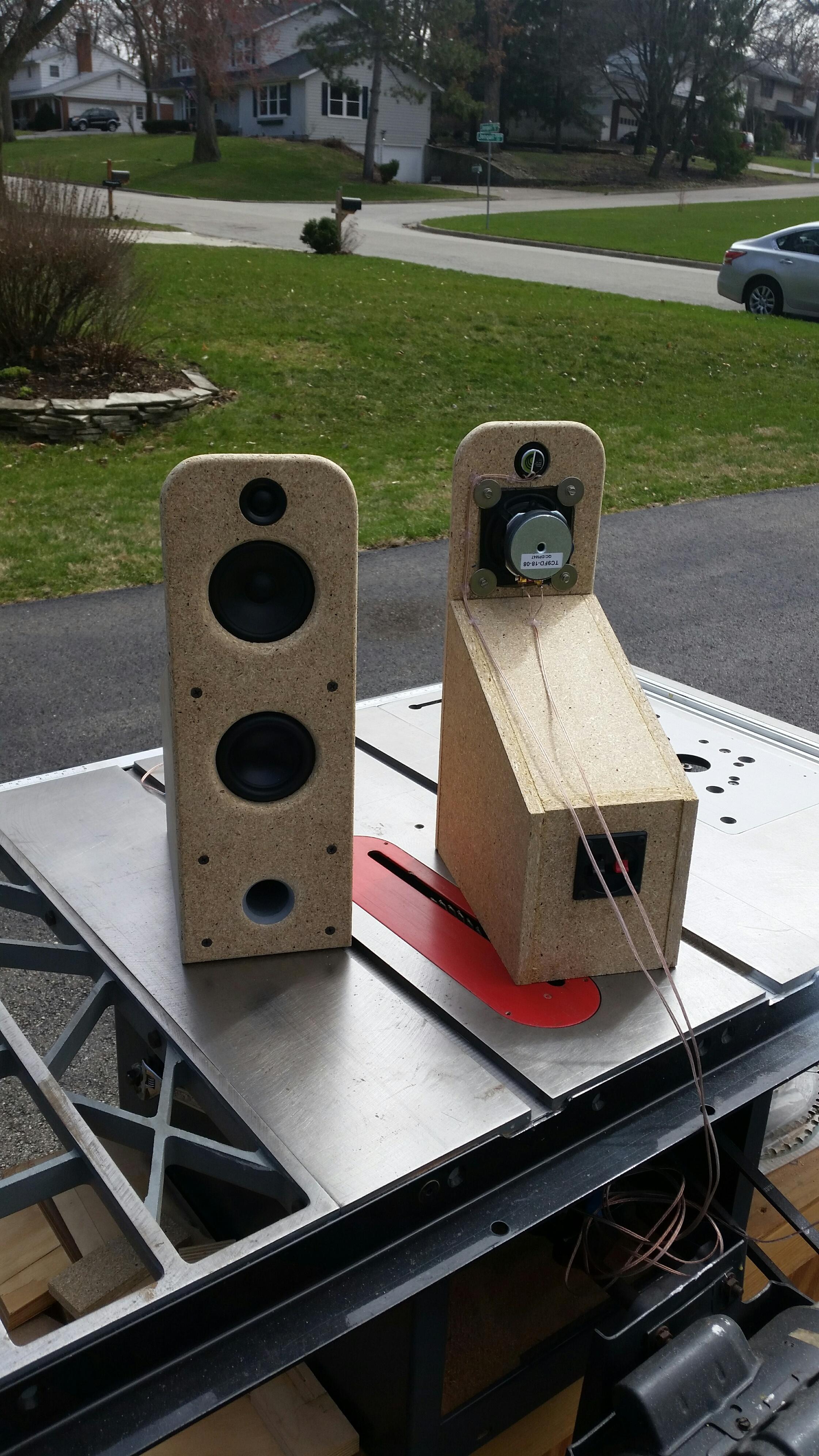Site Links
Howdy, Stranger!
It looks like you're new here. If you want to get involved, click one of these buttons!
Quick Links
Categories
In this Discussion
Who's Online (0)
Open Baffle Hybrid Design
Figured I would start a separate thread so as not to clutter Bill's "Plumbers" thread.
I made some more progress on my hybrid open baffle design. Let me stress again that these particle board boxes are strictly prototypes. That's why I didn't take the time or effort to flush trim the butt joints or fabricate fancy clamps to hold in the rear mounted drivers. Big old fender washers were good enough at this stage. They are hybrids because only the TC9FD mid is dipole. I have never measured an OB project, let alone designed a xo for it. I have a feeling that the power response may be more important than the on-axis frequency response. At any rate it will be a fun learning experience and I will have to trust my ears more. I picked up the ND90-8's when they were on sale for $17, so I don't have a lot of money invested in this project. Any comments and suggestions are greatly welcomed. I'll post the measurements when I complete them. Here's where I'm at right now (too nice of a day to spend in the basement measuring speakers):

I made some more progress on my hybrid open baffle design. Let me stress again that these particle board boxes are strictly prototypes. That's why I didn't take the time or effort to flush trim the butt joints or fabricate fancy clamps to hold in the rear mounted drivers. Big old fender washers were good enough at this stage. They are hybrids because only the TC9FD mid is dipole. I have never measured an OB project, let alone designed a xo for it. I have a feeling that the power response may be more important than the on-axis frequency response. At any rate it will be a fun learning experience and I will have to trust my ears more. I picked up the ND90-8's when they were on sale for $17, so I don't have a lot of money invested in this project. Any comments and suggestions are greatly welcomed. I'll post the measurements when I complete them. Here's where I'm at right now (too nice of a day to spend in the basement measuring speakers):






Comments
http://techtalk.parts-express.com/forum/speaker-project-gallery/57802-indy-ng-2-way-open-baffle-150-pair
The flat baffle behind the OB mid/ tweeter made the image project higher than the height of the mid/ tweeter.
It will be interesting if your image moves higher or does the tweeter hold it level...
BTW, is there a term for an M-M.5-W? Or am I destined to learn why not?
Anyone know what kind of wood this is? I seriously don't. I found the board in my wood pile. It's kind of light weight, almost as light as pine. But it is harder than pine but not nearly as hard as the hardwoods like hickory or walnut that I'm familiar with. Some sort of maple maybe?
The first prototype had a 1/2" thick baffle and needed the fender washers to mount the mid and woofer. This version uses a 3/4" thick baffle so I can use normal 1/2" long screws and not poke through the front. This should result in a much cleaner look.
The idea of the mid at the top is to minimize the baffle such that the dipole null moves higher in the frequency range. That allows the x-o point between the mid and the tweeter to be higher.
Crossing the tweeter at or below the first dipole null improves the off axis response (short answer).
You would measure at your listening axis. I usually try to make the tweeter location the listening and measuring axis.
I shared with Craig that when I built the Indy-NG project the mid/tweet rear response bounced off the top of the woofer box so the image was raised about 3 feet. I changed that in the Aperivox build
I should be taking measurements this weekend if the forecast is correct and it's raining.
I should have followed the shellac with a satin poly or lacquer. I set the baffles face down on my workbench to mark the driver screw holes. I thought the bench top was perfectly clean but there must have been a small something that left some indentation lines
Loaded baffles now attached to the woofer boxes... Let the measurements begin!
PS - you can clearly see the flaws on the left baffle above and below the tweeter's right side
With the brush you can always add more shellac then blend in. If using a rattle can I spray into the can top then dip in the brush.
This will work best if the baffle is horizontal.
This build makes me want to to do another OB mid...